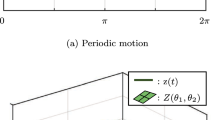Abstract
We treat the periodic trajectory tracking problem: given a periodic trajectory of a control-affine, left-invariant driftless system in a compact and connected Lie group G and an initial condition in G, find another trajectory of the system satisfying the initial condition given and that asymptotically tracks the periodic trajectory. We solve this problem locally (for initial conditions in a neighborhood of some point of the periodic trajectory) when G is semisimple and the system is Lie-determined (i.e., controllable), and only for a class of periodic trajectories (which we call regular). Finally, we present a set of sufficient conditions to ensure the existence of such trajectories.
Similar content being viewed by others
Notes
e: the identity element of G.
The adjoint map \(\text {Ad} : G \rightarrow \text {GL} (\mathfrak {g})\) is the group homomorphism that associates to each x ∈ G an invertible linear map \(\text {Ad} (x): \mathfrak {g} \rightarrow \mathfrak {g}\) as follows: if Ix stands for the map y ∈ G↦x ⋅ y ⋅ x− 1 ∈ G then Ad(x) corresponds to \(\text {d}\ (I_{x})_{e}: T_{e}G \rightarrow T_{e}G\) via the canonical isomorphism \(\mathfrak {g} \cong T_{e}G\).
For x ∈ G we denote by Lx (resp. Rx) the left (resp. right) translation map y ∈ G↦x ⋅ y ∈ G (resp. y ∈ G↦y ⋅ x ∈ G).
I.e., the distance between two given points is the infimum of the lengths of all piecewise smooth curves connecting them.
Given \(X \in \mathfrak {g}\) the adjoint map \(\text {ad} (X): \mathfrak {g} \rightarrow \mathfrak {g}\) is defined by \(Y \in \mathfrak {g} \mapsto [X,Y] \in \mathfrak {g}\). By means of the canonical isomorphism \(\mathfrak {g} \cong T_{e}G\) it makes perfect sense to write ad(v) for v ∈ TeG – as we do often throughout the text – which we regard as a linear map \(T_{e}G \rightarrow T_{e} G\). In that sense, \(\text {ad} : T_{e}G \rightarrow \mathfrak {gl}(T_{e}G)\) is precisely the differential of the adjoint map \(\text {Ad} : G \rightarrow \text {GL} (T_{e}G)\) at e ∈ G [3, Proposition 1.91].
Z(G): the center of G, i.e., the subgroup of all x ∈ G such that x ⋅ y = y ⋅ x for every y ∈ G. Since G is compact, it is semisimple if and only if Z(G) is discrete [3, Corollary 4.25].
See footnote 8.
An inner product on \(\mathfrak {g}\) is said to be Ad-invariant if Ad(x) is orthogonal w.r.t. it for every x ∈ G. Such an inner product always exists when G is compact, and thanks to the relationship between the adjoint maps (see footnote 5) one also has that ad(X) is skew-symmetric w.r.t. it for every \(X \in \mathfrak {g}\) [3, Proposition 4.24]. In particular, trace ad(X) = 0 for every \(X \in \mathfrak {g}\).
Here and below we denote by eX ∈ G the exponential of \(X \in \mathfrak {g}\).
This is Cartan’s Criterion for Semisimplicity [3, Theorem 1.45]: the Killing form of \(\mathfrak {g}\) is the bilinear form \(B: \mathfrak {g} \times \mathfrak {g} \rightarrow \mathfrak {g}\) defined by \(B(X,Y) {\dot {=}} \text {trace}\ \{ \text {ad} (X) \cdot \text {ad} (Y) \}\). It is always negative semidefinite, while non-degenerate precisely when G is semisimple.
References
Jurdjevic V. Geometric control theory, volume 52 of Cambridge Studies in Advanced Mathematics. Cambridge: Cambridge University Press; 1997.
Khalil HK. Nonlinear system, 3rd ed. Upper Saddle River: Prentice Hall; 2002.
Knapp AW. Lie groups beyond an introduction, volume 140 of Progress in Mathematics. Boston: Birkhäuser; 1996.
LaSalle JP. An invariance principle in the theory of stability Technical Report 66-1, Center for Dynamical Systems. Providence, Brown University; 1966.
Sachkov YL. Control theory on Lie groups. Sovrem Mat Fundam Napravl 2007; 27:5–59.
Silveira HB. Formas Triangulares para Sistemas nao-lineares com Duas Entradas e Controle de Sistemas Sem Arrasto em SU(n) com Aplicaçoes em Mecânica Quântica. PhD thesis. Sao Paulo, University of Sao Paulo; 2009.
Silveira HB, Pereira da Silva PS, Rouchon P. 2009. A time-periodic Lyapunov approach for motion planning of controllable driftless systems on SU(n). In: Proceedings of the 48h IEEE Conference on Decision and Control (CDC) held jointly with 2009 28th Chinese Control Conference, pp 363–368.
Silveira HB, Pereira da Silva PS, Rouchon P. Quantum gate generation by T-sampling stabilisation. Internat J Control 2014;87(6):1227–1242.
Acknowledgments
I wish to thank H. B. Silveira and P. A. Tonelli for reading the original manuscript and making invaluable suggestions, and the latter also for many long discussions and for proposing the problem. I am also indebted to an anonymous reviewer for many relevant suggestions.
Funding
This work was partially supported by Conselho Nacional de Desenvolvimento Científico e Tecnológico (CNPq, grants 131876/2010-4 and 140838/2012-0) and the São Paulo Research Foundation (FAPESP, grant 2018/12273-5).
Author information
Authors and Affiliations
Corresponding author
Additional information
Publisher’s Note
Springer Nature remains neutral with regard to jurisdictional claims in published maps and institutional affiliations.
Rights and permissions
About this article
Cite this article
Araújo, G. Periodic Trajectory Tracking for Control-Affine Driftless Systems on Compact Lie Groups. J Dyn Control Syst 26, 557–579 (2020). https://doi.org/10.1007/s10883-019-09468-z
Received:
Revised:
Published:
Issue Date:
DOI: https://doi.org/10.1007/s10883-019-09468-z




